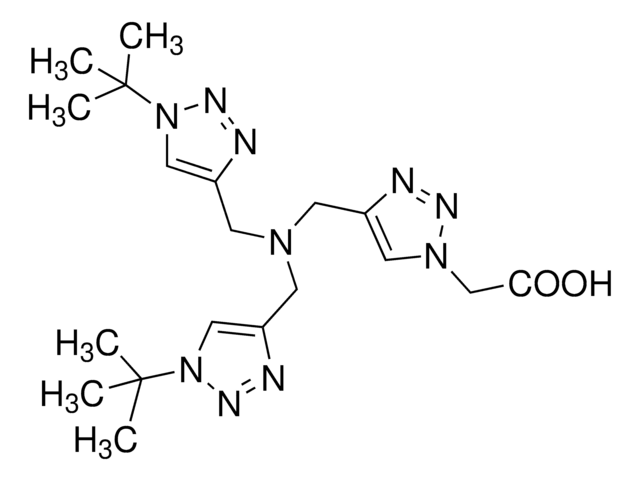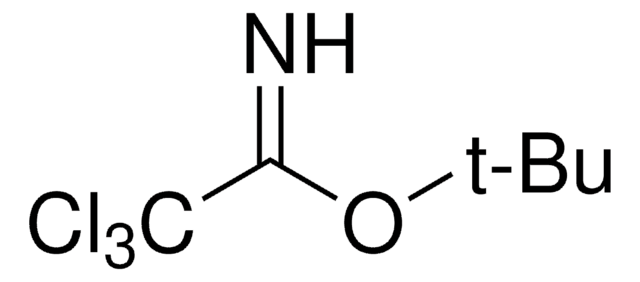678937
Tris[(1-benzyl-1H-1,2,3-triazol-4-yl)methyl]amine
97%
Synonym(s):
TBTA
Sign Into View Organizational & Contract Pricing
All Photos(3)
About This Item
Empirical Formula (Hill Notation):
C30H30N10
CAS Number:
Molecular Weight:
530.63
MDL number:
UNSPSC Code:
12161600
PubChem Substance ID:
NACRES:
NA.22
Recommended Products
Quality Level
Assay
97%
form
solid
reaction suitability
reagent type: ligand
reaction type: click chemistry
mp
132-143 °C
storage temp.
−20°C
SMILES string
C(N(Cc1cn(Cc2ccccc2)nn1)Cc3cn(Cc4ccccc4)nn3)c5cn(Cc6ccccc6)nn5
InChI
1S/C30H30N10/c1-4-10-25(11-5-1)16-38-22-28(31-34-38)19-37(20-29-23-39(35-32-29)17-26-12-6-2-7-13-26)21-30-24-40(36-33-30)18-27-14-8-3-9-15-27/h1-15,22-24H,16-21H2
InChI key
WKGZJBVXZWCZQC-UHFFFAOYSA-N
Related Categories
Application
A polytriazolylamine ligand which stabilizes Cu(I) towards disproportionation and oxidation thus enhancing its catalytic effect in the azide-acetylene cycloaddition.
related product
Product No.
Description
Pricing
Hazard Statements
Hazard Classifications
Aquatic Chronic 4
Storage Class Code
11 - Combustible Solids
WGK
WGK 3
Flash Point(F)
Not applicable
Flash Point(C)
Not applicable
Personal Protective Equipment
dust mask type N95 (US), Eyeshields, Gloves
Choose from one of the most recent versions:
Already Own This Product?
Find documentation for the products that you have recently purchased in the Document Library.
Customers Also Viewed
Qian Wang et al.
Journal of the American Chemical Society, 125(11), 3192-3193 (2003-03-13)
The copper-catalyzed cycloaddition reaction between azides and alkynes functions efficiently in aqueous solution in the presence of a tris(triazolyl)amine ligand. The process has been employed to make rapid and reliable covalent connections to micromolar concentrations of protein decorated with either
Laurie D Cohen et al.
PloS one, 8(5), e63191-e63191 (2013-05-10)
Chemical synapses contain multitudes of proteins, which in common with all proteins, have finite lifetimes and therefore need to be continuously replaced. Given the huge numbers of synaptic connections typical neurons form, the demand to maintain the protein contents of
Frank Iversen et al.
Theranostics, 3(3), 201-209 (2013-03-09)
Some of the main concerns with in vivo application of naked small interfering RNA are rapid degradation and urinary excretion resulting in a short plasma half-life. In this study we investigated how conjugation of polyethylene glycol (PEG) with variable chain
Mark N Adams et al.
PloS one, 6(11), e28018-e28018 (2011-12-06)
Protease-activated receptor-2 (PAR2) is a G protein coupled receptor (GPCR) activated by proteolytic cleavage of its amino terminal domain by trypsin-like serine proteases. This irreversible activation mechanism leads to rapid receptor desensitization by internalisation and degradation. We have explored the
Brent R Martin et al.
Nature methods, 9(1), 84-89 (2011-11-08)
The reversible thioester linkage of palmitic acid on cysteines, known as protein S-palmitoylation, facilitates the membrane association and proper subcellular localization of proteins. Here we report the metabolic incorporation of the palmitic acid analog 17-octadecynoic acid (17-ODYA) in combination with
Our team of scientists has experience in all areas of research including Life Science, Material Science, Chemical Synthesis, Chromatography, Analytical and many others.
Contact Technical Service











